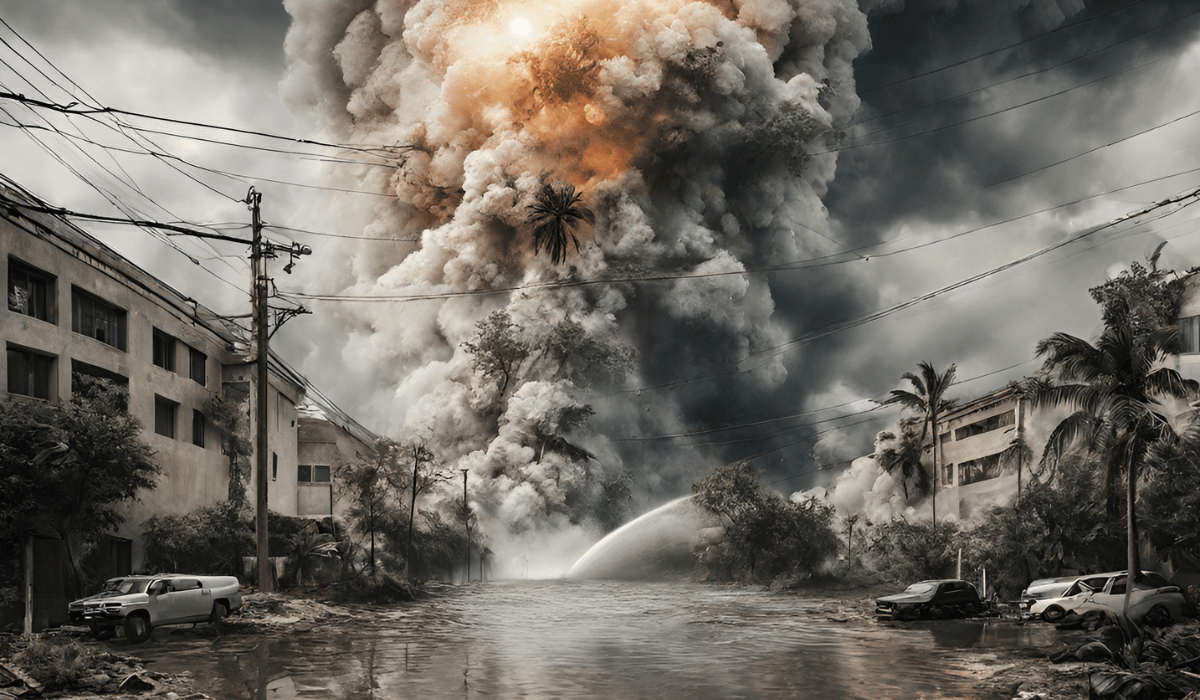Introduction
A Brief Explanation Of The Impact Of Natural Disasters On The Security Of Sensitive Data

Natural disasters can cause significant damage to physical infrastructure, which can lead to interruptions in data center operations and the loss of sensitive data. For example, floods or hurricanes can knock out power lines and destroy backup generators that are crucial for maintaining the functionality of data centers. Additionally, natural disasters can lead to the destruction of hard drives, servers, and other critical hardware components.
In addition to physical damage caused by natural disasters, there is also an increased risk of cyber attacks during these times. Malicious actors are known to take advantage of disaster situations by launching phishing attacks or distributing malware via social engineering tactics. This puts sensitive data at even greater risk because it increases the likelihood that attackers will be able to gain access undetected.
Importance Of The Topic For Individuals And Businesses

Individuals store a vast amount of sensitive information on their personal devices, including credit card details, social security numbers, and confidential emails. In the event of a disaster, such as a hurricane or an earthquake, these devices can be damaged or destroyed, resulting in the loss of important data. This can lead to identity theft and other serious consequences.
Businesses also face significant risks when it comes to natural disasters and data security. Companies store large amounts of valuable customer information that is critical to their operations. If this information is lost due to a disaster, companies may struggle to recover from the damage caused by the loss of data. Additionally, businesses need to ensure that they have proper backup systems in place so that they can quickly recover from any disruptions caused by natural disasters.
Understanding the risks associated with natural disasters and data security is essential for both individuals and businesses in today’s digital landscape. By taking proactive measures to protect sensitive information, people can minimize the potential impact of any future disasters on their personal lives or livelihoods while safeguarding against possible cyber threats at all times.
Understanding Natural Disasters and Their Impact on Sensitive Data
Types Of Natural Disasters That Can Pose A Risk To Sensitive Data Security

They may not be the first risk factor that comes to mind, but natural disasters such as floods, hurricanes, earthquakes, and wildfires can pose a severe threat to an organization’s data protection measures. Flooding can lead to water damage of physical hardware components and also result in power outages or electrical surges that can cause irreversible harm to servers or other interconnected devices. Similarly, hurricanes often come with strong winds and heavy rains that can knock over power lines and flood entire areas in their paths.
Earthquakes have the potential for both physical destructions of storage facilities as well as causing crucial electronics to fail during tremors. The impact of these disastrous events is not limited by geography or climate either; wildfires are becoming increasingly common worldwide due to rising temperatures caused by global warming. These fires can spread rapidly, engulfing everything in their way – including buildings where sensitive data is stored.
Factors That Determine The Extent Of Damage To Sensitive Data During A Natural Disaster
Type and severity of the disaster: For instance, a flood might cause more extensive damage than an earthquake or a hurricane. Similarly, an event like a wildfire could cause significant data loss, especially if the fire destroys critical infrastructure.
Location: If data centers or servers are located in areas prone to natural disasters, they are far more likely to be affected by them. For example, if your company’s server room is in an area with a high risk for floods or earthquakes, you might need to take extra precautions such as setting up secondary backup systems.
Preparation: Preparedness also plays a crucial role in determining how much damage sensitive data will sustain during natural disasters. Companies that have robust disaster recovery plans and comprehensive backup strategies can quickly restore lost information compared to those that don’t have any plan at all.
Vulnerabilities in Sensitive Data Security Systems During Natural Disasters
Weaknesses In Physical Security Measures During Natural Disasters
During natural disasters, physical security measures tend to weaken. This is because the disaster itself can cause damage to buildings and infrastructure that houses important data. Furthermore, during natural disasters, people are more focused on evacuating and ensuring their own safety rather than protecting sensitive information. This can lead to a lack of oversight in securing physical documents or equipment containing sensitive data.
For example, if a building is damaged during a hurricane or tornado and employees are unable to access the office due to safety concerns or road closures, then important documents may be left behind unsecured. Additionally, if there is flooding or power outages during a natural disaster, security cameras, and alarms may fail to leave the equipment vulnerable.
Threats Posed By Power Outages And Communication Failures
When power grids are knocked offline, servers and data centers that rely on electricity to operate can become inaccessible, leading to downtime and data loss. Additionally, communication failures can make it difficult for employees to coordinate response efforts and for stakeholders to receive updates on the status of critical systems.
In extreme cases, power outages and communication failures can even leave businesses vulnerable to cyber attacks. Without access to essential systems or communication channels, organizations may struggle to detect or respond effectively to malicious activity targeting their networks or sensitive information.
Importance of disaster recovery plans in mitigating the risk of data loss
Disaster recovery plans help organizations recover from natural disasters faster by providing guidelines on how to restore disrupted services and systems. Additionally, these plans help businesses protect their reputation by minimizing downtime and ensuring customers’ trust is not compromised. Disaster recovery planning also helps companies comply with regulatory requirements for data protection.
Legal and Regulatory Implications of Natural Disaster-Related Data Breaches
Overview Of Relevant Laws And Regulations
It’s essential to have a proper disaster recovery plan in place. However, companies must also consider relevant laws and regulations when developing such a plan. For instance, the General Data Protection Regulation (GDPR) imposes strict standards on how organizations collect and process personal data. Companies must comply with GDPR guidelines even during a natural disaster.
The Health Insurance Portability and Accountability Act (HIPAA) also requires healthcare providers to maintain patient confidentiality during an emergency or disaster situation. This means that healthcare providers must have plans in place for protecting electronic health records or other sensitive documents from damage or unauthorized access.
Moreover, businesses should be aware of state-specific data breach notification laws that require them to notify individuals if their personal information is at risk due to a natural disaster. These laws often impose strict timelines for notifications, so companies need to have systems in place that are capable of quickly identifying affected individuals and providing timely notifications.
Consequences Of Non-Compliance
The failure to adhere to recovery protocols, such as backing up data on a regular basis or implementing contingency measures, can result in catastrophic losses and even put a company out of business. These losses can include not just financial damage, but also reputational damage that may be difficult to overcome.
In addition to the potential loss of sensitive data, non-compliance with disaster recovery plans may also lead to legal penalties and hefty fines from regulators. Failing to meet industry standards for data protection and storage during a natural disaster could result in lawsuits from customers or partners whose information has been compromised. Such lawsuits not only represent significant financial costs but also expose companies to public scrutiny and criticism that could harm their reputation long-term.
Importance Of Compliance With Regulations In Protecting Sensitive Data During Natural Disasters
Compliance with regulations like the GDPR and HIPAA ensures that sensitive data is protected even during times of crisis. For instance, the General Data Protection Regulation (GDPR) mandates that organizations must have measures in place to protect personal data from loss or unauthorized access. This includes devising a disaster recovery plan that takes into account potential risks and vulnerabilities.
Moreover, compliance helps organizations maintain their reputation by showing customers and stakeholders that they take data protection seriously. In addition to compliance, it’s also important for organizations to have regular backup plans in place so they can quickly restore any lost or damaged data after a natural disaster strikes.
Best Practices for Protecting Sensitive Data During Natural Disasters
Importance Of Risk Assessments And Disaster Recovery Planning
To minimize the risk of data loss or breach, it is essential to conduct regular risk assessments and develop a comprehensive disaster recovery plan. Risk assessments help identify potential vulnerabilities in the system that could be exploited during natural disasters. By identifying these vulnerabilities, companies can take proactive measures to secure their infrastructure and prevent data loss.
Disaster recovery planning involves creating a roadmap for how the company will respond to different types of natural disasters. This includes outlining steps for backup and restoration of critical systems, communication protocols between employees, customers, and vendors during an emergency situation, and identification of alternative locations where business operations can continue in case the primary location is unavailable due to damage caused by a natural disaster. A well-crafted disaster recovery plan ensures that organizations have strategies in place to recover quickly from any disruption caused by natural disasters.
Implementation Of Physical Security Measures To Protect Sensitive Data
A comprehensive and effective physical security plan involves several elements such as entry control mechanisms, surveillance systems, and environmental controls. Access control mechanisms such as card readers, biometric scanners, and keypads can be implemented to restrict access to areas where sensitive data is stored. Surveillance systems like CCTV cameras can monitor access points and record any suspicious activities that may occur.
Environmental controls include fire suppression systems, and temperature and humidity monitoring sensors that help maintain optimal conditions for storing hardware that contains sensitive information. Overall, implementing physical security measures effectively helps mitigate risks associated with natural disasters on sensitive data.
Back-Up And Recovery Strategies For Sensitive Data
It is essential to implement back-up and recovery strategies that protect your data from these risks. One strategy is to conduct regular backups of your data on an external hard drive or cloud-based storage system. This ensures that you have access to critical information even in the event of a disaster.
Another strategy is to create multiple copies of your data and store them in different locations. This protects against the risk of losing all copies in a single location due to natural disasters like floods or fires. It’s also important to test these backup systems regularly by restoring them on another device or system to ensure they are working correctly.
Consider investing in disaster recovery services from reputable providers who specialize in protecting sensitive data from natural disasters. These service providers will help you create customized plans for backing up and recovering your data based on the specific risks faced by your business or organization.
Employee Training And Education
By providing employees with the proper training, they will know how to respond in a crisis, which can help reduce downtime and minimize data loss. Employee training should cover topics such as identifying potential hazards, emergency response procedures, and data backup strategies. Regular drills can also help ensure that all employees understand their roles during a disaster and know how to effectively communicate with one another. Additionally, companies may consider investing in educational resources that teach employees about cybersecurity best practices.
Frequently Asked Questions
What types of natural disasters pose the greatest risk to sensitive data security?
Hurricanes and floods are among the most devastating natural disasters that can impact sensitive data security. These events can cause extensive water damage, leading to the destruction of hardware and loss of data.
Wildfires are another type of natural disaster that poses a great risk to sensitive data security. Flames engulfing buildings and infrastructure can lead to complete loss of physical devices such as servers, hard drives, or backups in addition to exposing confidential information to unauthorized access.
Earthquakes also pose a threat as they can cause structural damage, fires, power outages, network failures, or total infrastructure destructions which may result in permanent loss of critical business information unless there is an effective backup system in place.
How can I protect my sensitive data during a natural disaster?
You can protect your sensitive data during a natural disaster by storing your files and documents in the cloud. Cloud storage services like Dropbox and Google Drive allow you to back up and store important files securely online. This way, even if your physical devices are damaged or destroyed during a natural disaster, you’ll still have access to all of your important information.
Another measure you should take when protecting your sensitive data during a natural disaster is encrypting all of your files. Encryption scrambles the contents of files so that they cannot be read by unauthorized users. By encrypting all of your sensitive data before uploading it onto cloud storage services or other digital platforms, you significantly reduce the risk of unauthorized access in the event of theft or damage from a natural disaster.
What should I do if my sensitive data is compromised during a natural disaster?
Ensure that you are safe and seek medical attention if necessary. Then, report the incident immediately to the relevant authorities or organizations responsible for managing such disasters.
Take steps to secure any remaining sensitive data. This may include contacting your bank or financial institutions to cancel any credit cards or freeze accounts that may have been compromised in the event of a flood or fire. You can also change passwords on important accounts and enable two-factor authentication where possible.
Document any damage caused by the natural disaster with photographs and videos as evidence for insurance purposes. It is important to keep all documentation related to incidents involving sensitive data security breaches during natural disasters since it can play a crucial role in future legal proceedings should they arise.
What can businesses and organizations do to prepare for natural disasters and protect their sensitive data?
Businesses can prepare for natural disasters by creating backups of all their important data and storing them offsite or in the cloud. This ensures that even if their primary systems are damaged or destroyed during a disaster, they still have access to crucial business files and information. It’s also vital to conduct regular risk assessments and implement proper security measures such as firewalls and antivirus software to prevent cyber-attacks.
In addition to taking these precautionary measures, organizations should also develop an emergency response plan detailing how employees should react during a disaster. The plan should include steps like evacuation procedures, communication protocols, power shutdown processes, and security measures that need implementation during the crisis period.
Conclusion
Natural disasters pose a serious risk to sensitive data security. The potential damage to physical infrastructure and power outages caused by these events can result in the loss or theft of critical information. Organizations must take proactive measures to safeguard their data, including investing in disaster recovery plans and backup systems.
Furthermore, it is essential for companies to regularly review and update their disaster preparedness strategies. This includes conducting risk assessments that take into account the likelihood of natural disasters occurring in their area, as well as implementing effective communication protocols with employees and stakeholders during emergencies.
